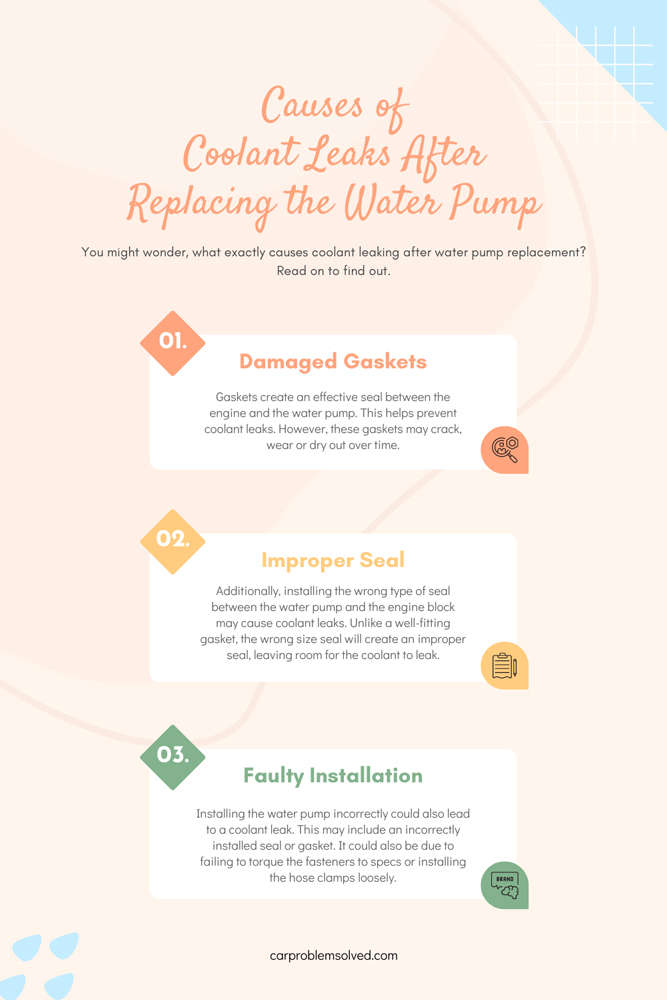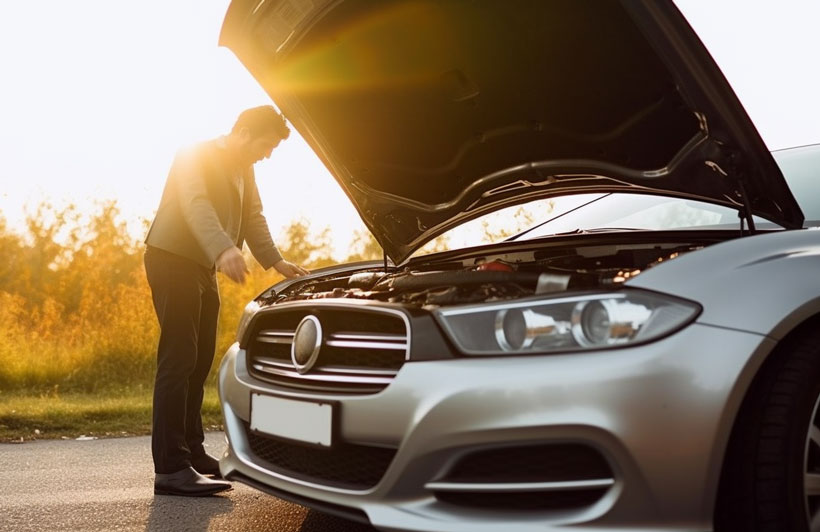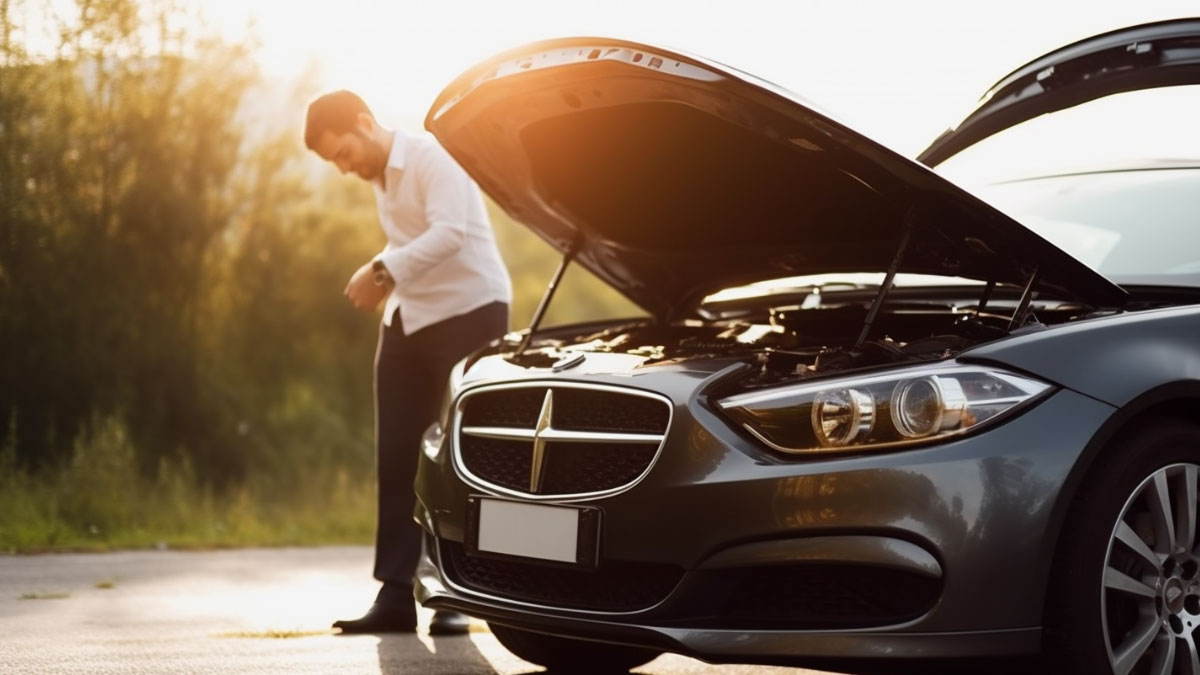Your vehicle’s water pump is critical in moving the coolant from the radiator to the engine block. This helps ensure the engine does not overheat. For this reason, it is normal to experience coolant leaks after replacing the water pump.
But what are the causes and solutions for coolant leaking after installing a new water pump in your engine? Apart from improper installation, this problem may occur due to faulty gaskets and inappropriate seals. The good news? Replacing the gaskets, improving the seals, and reinstalling the pump may help fix the problem.
So then, how do you diagnose the coolant leaks? Stay with us till the end to learn all about coolant leaking after replacing the water pump. You can also have tips to prevent coolant-related problems.
The Importance of the Water Pump in the Cooling System

A water pump is the heart of your vehicle’s cooling system. This device helps circulate the coolant throughout the engine block via the radiator hoses. Consequently, this ensures optimum engine operating temperatures are maintained. The benefits of a water pump include the following:
- Protecting the engine from overheating
- Providing a comfortable and quiet car ride
- Protecting engine components from damage
- Preventing corrosion in the engine
- Improving fuel efficiency by maintaining correct engine temperatures
Diagnosing Coolant Leaks After a Water Pump Replacement
It is not unusual to experience coolant leaks after replacing the water pump. So, below are simple ways of diagnosing coolant leaks.stening for Unusual

Inspecting for Coolant Leaks
- Start by checking for visible signs of yellow, pink, or green colored fluid around the hoses, radiator cap, and through the engine block.
- Also, inspect the water pump gasket for signs of tears and cracks.
- In addition, check the hose clamps for signs of looseness or damage.
- More importantly, inspect the coolant level, which should be between the full (F) and low (L) marks.
Looking for Rust and Corrosion
- If you cannot spot coolant leaks, look for yellowish and reddish spots on the water pump’s surface or in your coolant. Such discoloration is a sign of rust and corrosion due to coolant leaks.
- You could also check for rust and corrosion on various engine components, including the pistons, crankshaft, and valve springs. This is because these parts are made of metal alloys.
Listening to Unusual Noises
- Listen for a hissing sound from the engine cylinder while driving or after switching the engine off. Such a sound could be due to a leaking coolant causing the engine to overheat.
- Additionally, if the coolant leaks onto your car’s drive belt, the belt may slip and make squealing noises.
- You may also hear a whining noise from the front of the engine if the water pump is installed incorrectly.
Check the Temperature Gauge
When there is insufficient coolant in the cooling tank due to a leak, your vehicle’s engine will overheat. Consequently, the temperature gauge may indicate a temperature rise.
Causes of Coolant Leaks After Replacing the Water Pump

You might wonder, what exactly causes coolant leaking after water pump replacement? Read on to find out.
Damaged Gaskets
Gaskets create an effective seal between the engine and the water pump. This helps prevent coolant leaks. However, these gaskets may crack, wear or dry out over time.
So, if you replace the water pump but not the damaged gasket, you may experience coolant leaks from the water pump. Sometimes, the gaskets may get damaged due to over-tightening the bolts that secure the water pump to the engine.
Improper Seal
Additionally, installing the wrong type of seal between the water pump and the engine block may cause coolant leaks. Unlike a well-fitting gasket, the wrong size seal will create an improper seal, leaving room for the coolant to leak.

Faulty Installation
Installing the water pump incorrectly could also lead to a coolant leak. This may include an incorrectly installed seal or gasket. It could also be due to failing to torque the fasteners to specs or installing the hose clamps loosely.
Solutions for Addressing Coolant Leaks After Replacing the Water Pump

Now that you know the causes of coolant leaks from the water pump and cooling system, what are the solutions? Keep reading to find out.
1. Replacing the Gaskets
A faulty gasket cannot be repaired. It would help if you replaced it immediately to prevent more coolant leaks. Here is a step-by-step guide on how to do the replacement.
Step 1: Let the engine cool down and drain all the coolant from the coolant tank.
Step 2: Disconnect the coolant lines, hoses, and other components leading to the water pump.
Step 3: Unfasten the water pump from the engine.
Step 4: Remove the old gasket and clean the gasket surface, ensuring there are no leftover materials.
Step 5: Install the new gasket on the water pump.
Step 6: Reinstall the water pump onto the engine and reconnect all the components you had disconnected.
Step 7: Bleed air from the cooling system and refill the coolant.

2. Improving the Seal
Another way to solve coolant leaks after water pump replacement is to improve the seal between the engine and the pump. You can do this by installing the correct-sized seal based on the model of your car.
In addition, you could add a gasket material or sealant around the seal if the manufacturer instructs you to do it. However, most installation instructions only recommend applying oil or coolant on the seals to enhance their performance.
3. Reinstallation
What happens if the cause of the coolant leaking after replacing the water pump is a faulty installation? In this case, you will have to disassemble and reinstall the pump. The steps for reinstalling the water pump correctly are the same as how to replace the gasket. Check them above.
While reinstalling the water pump, ensure the hose clamps are not loose but tight. Also, ensure to torque the fasteners securing the water pump to the engine according to specs.
Preventive Maintenance Tips for Avoiding Coolant-Related Problems

Below we will discuss the preventive maintenance tips you can practice to minimize coolant-related problems.
Regular Maintenance
You should regularly check the coolant level and top it off when needed. Also, you must periodically flush the cooling system to keep off unwanted debris and rust deposits that build up over time.
More importantly, it would help if you change the coolant regularly. Typically, most owner’s manuals recommend changing the coolant every 30,000 miles or two years.
Coolant System Checks
The coolant system comprises various parts, including the water pump, hoses, thermostat, radiator, cooling fan, and engine. So, you must regularly inspect these components for cracks, wear, and damage to prevent coolant-related problems.

Monitoring Temperature Gauge
The temperature gauge is designed to alert you when your vehicle’s engine runs extremely hot. So, monitoring the indicator will ensure you know when the engine is overheating, probably due to the coolant leaking. Consequently, you can take action before further damage occurs.
If you’ve recently replaced the water pump in your car and are experiencing coolant leakage, it’s crucial to address the issue promptly. However, if you’re also concerned about your car going through coolant rapidly, it’s essential to understand the underlying causes. Our article on why is my car going through coolant so fast discusses various factors that can contribute to excessive coolant consumption, providing insights and potential solutions. Additionally, if you suspect that your coolant is not circulating properly, it’s important to diagnose the issue to prevent engine overheating. Our article on why is my coolant not circulating explores common causes and solutions for this concern. By understanding these related topics, you can effectively address coolant-related issues and ensure the proper functioning of your vehicle’s cooling system.Conclusion
After replacing the water pump, you should inspect all the hoses connected to the pump for any damage. Also, check if the hose clamps are tightly fastened to avoid costly engine repairs due to coolant leaks. Also, inspect the gaskets and seals for damage.
Another way to address coolant leaks after replacing the water pump is to ensure the radiator cap is firmly fastened. Additionally, you should check the radiator and the thermostat for signs of corrosion and replace the parts if necessary. Last but not least, confirm that the water pump is installed correctly.
